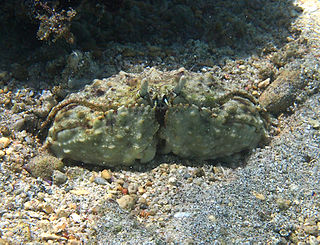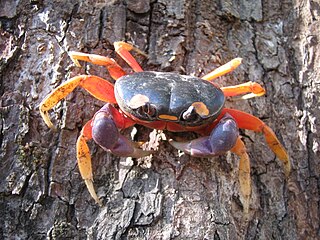
Xanthidae is a family of crabs known as gorilla crabs, mud crabs, pebble crabs or rubble crabs. Xanthid crabs are often brightly coloured and are highly poisonous, containing toxins which are not destroyed by cooking and for which no antidote is known. The toxins are similar to the tetrodotoxin and saxitoxin produced by puffer fish, and may be produced by bacteria in the genus Vibrio living in symbiosis with the crabs, mostly V. alginolyticus and V. parahaemolyticus.

Calappa is a genus of crabs known commonly as box crabs or shame-faced crabs. The name box crab comes from their distinctly bulky carapace, and the name shame-faced is from anthropomorphising the way the crab's chelae (claws) fold up and cover its face, as if it were hiding its face in shame.

Tuerkayana hirtipes is a species of terrestrial crab.

Discoplax is a genus of terrestrial crabs. It is very closely related to the genus Cardisoma.

Discoplax longipes is a species of terrestrial crab. It is found in karstic caves on Pacific islands and ranges from the Loyalty Islands to French Polynesia. Mating occurs in the caves, after which the females migrate to the sea to release their fertilised eggs. The genus Discoplax was for a long time synonymised with Cardisoma, but was resurrected in the late 20th century.

The Gecarcinidae, the land crabs, are a family of true crabs that are adapted for terrestrial existence. Similar to all other crabs, land crabs possess a series of gills. In addition, the part of the carapace covering the gills is inflated and equipped with blood vessels. These organs extract oxygen from the air, analogous to the vertebrate lungs. Adult land crabs are terrestrial, but visit the sea periodically, where they breed and their larvae develop. Land crabs are tropical omnivores which sometimes cause considerable damage to crops. Most land crabs have one of their claws larger than the other.

Cardisoma is a genus of large land crabs. Three species formerly placed in this genus are now placed in Discoplax. The four species that remain in Cardisoma are found in warm coastal regions where they live in burrows. Young individuals are often very colourful with a purple-blue carapace and orange-red legs, but as they grow older the colours tend to fade, and females may be duller than males. Although less extreme than in fiddler crabs, one claw is usually considerably larger than the other. They are omnivores, but primarily feed on plant material.

Gecarcinus is the type genus of the land crab family Gecarcinidae. They are found in warmer coastal regions of the Americas, including islands in the Caribbean. Four species from oceanic islands were formerly included in Gecarcinus as the subgenus Johngarthia, but are now treated as a separate genus, Johngarthia. While all members of this genus are largely terrestrial, they have to return to the ocean to breed. They are often colourful, with reddish, orange, purple, yellowish, whitish, or blackish being the dominating hues. This has resulted in some species, notably G. quadratus and G. lateralis, gaining a level of popularity in the pet trade.

Johngarthia is a genus of crabs in the land crab family Gecarcinidae, formerly included in the genus Gecarcinus, and containing six species. The genus bears the name of John S. Garth, a 20th century naturalist who specialized in crabs and other arthropods.

Epigrapsus is genus of terrestrial crabs. The two species are omnivores.

Hexapodidae is a family of crabs, the only family in the superfamily Hexapodoidea. It has traditionally been treated as a subfamily of the family Goneplacidae, and was originally described as a subfamily of Pinnotheridae. Its members can be distinguished from all other true crabs by the reduction of the thorax, such that only seven sternites are exposed, and only four pairs of pereiopods are present. Not counting the enlarged pair of claws, this leaves only six walking legs, from which the type genus Hexapus, and therefore the whole family, takes its name. Some anomuran "crabs", such as porcelain crabs and king crabs also have only four visible pairs of legs. With the exception of Stevea williamsi, from Mexico, all the extant members are found either in the Indo-Pacific oceans, or around the coast of Africa.

Romaleon is a genus of marine crabs formerly considered in the genus Cancer.

Cheiragonidae is a small family of crabs, sometimes called helmet crabs, placed in its own superfamily, Cheriagonoidea. It comprises three extant species, Erimacrus isenbeckii, Telmessus acutidens and Telmessus cheiragonus, there are no yet evidences of Cheiragonidae in the fossil record. Many of these crabs were formerly treated as members of the Atelecyclidae.

Cardisoma crassum, known as the mouthless crab, is a species of terrestrial crab found in the coastal tropical eastern Pacific from Baja California to Peru.
Tanaocheles is a genus of crabs, the only genus in the family Tanaocheleidae. It contains two species, T. bidentata and T. stenochilus. The two species were formerly placed in different families, and they were only shown to be related, and placed in a new subfamily, in 2000.

Gecarcinus ruricola is a species of terrestrial crab. It is the most terrestrial of the Caribbean land crabs, and is found from western Cuba across the Antilles as far east as Barbados. Common names for G. ruricola include the purple land crab, black land crab, red land crab, and zombie crab.

Karstarma is a genus of karst-dwelling crabs formerly included in Sesarmoides.

Cancrocaeca xenomorpha is a species of troglobitic (cave-dwelling) freshwater crab from Sulawesi, the only species in the monotypic genus Cancrocaeca. It has been described as the world's "most highly cave-adapted species of crab".

Johngarthia planata is a bright orange species of land crab that lives on inshore islands and the continental mainland coast of the tropical and subtropical Pacific coast of the Americas, including the Gulf of California, Costa Rica, Colombia, and continental mainland beaches of Mexico. The crabs are omnivorous and feed on seaweed (algae), vegetation and sometimes carrion.

Leptograpsodes octodentatus, known as the burrowing shore crab, is a species of crab in the superfamily Grapsoidea, It is the only species in the genus Leptograpsodes, and the family Leptograpsodidae.




















